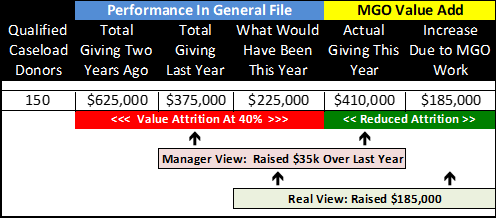Nope. Never. Not going to happen. Won’t happen. Can’t happen. Not true.
It’s truly unbelievable to Jeff and me that smart, competent non-profit leaders can’t embrace the fact that a good major gifts program works and is worth the investment.
These are the people I call the “major gift naysayers.”
No matter what you say to them, they don’t believe it. You show them numbers and make a logical case. And they imply you’ve “cooked the numbers” or are presenting a case that isn’t totally clear or right.
Let me share with you about the case of the organization that had 25 MGOs. They had a major gift program going for 15 years. The average value per caseload was $350,000 for total revenue of $8.75 million. Let’s stop here. Is there something wrong with this scenario? Yep. Now, to be clear, a STARTING value of a caseload of $350,000 is good. But after 15 years? Something ain’t right!
OK, that’s context.
The next part of this case is when Veritus came in to help this organization and in one year the caseload value went up to $450,000 for total revenue of $11.25 million. The third year increased to $710,000 average value and total revenue of $17.75 million. Then in the fourth year, we had $905,000 in average value for a total revenue of $23 million.
And a new leader comes in, who is cost-focused, and cancels the program.
This is a leader who employs a manager who parses out toilet paper and other paper products in their office so there is no significant waste!
You think I’m making this up? Nope. This really happened.
There’s another case of a manager who, prior to the program beginning, was shown facts about the state of her active donor file. Her file showed that the donors with $1,000+ cumulative giving had a value attrition of 45% a year!
Let’s get the details down clearly. There are 2,000 active donors giving $1,000 cume or more in one fiscal 12-month period. The average gift is $2,500. That would be 2,000 donors times $2,500 for a total of $5 million. That’s what they gave two years ago. Last year these same donors gave $2.75 million, or 45% less.
This is what these numbers look like in graphic form:

So, we’re showing this manager that her organization lost $2.25 million dollars. And it wasn’t one big gift that went away. It was hundreds of donors who either didn’t give or gave less.
OK, this manager has seen these numbers. She’s trained in finance and business and has an impressive work history. So, she understands the numbers here.
Now, we show her 150 donors that the MGO has qualified out of that group of 2,000 donors and what their performance has been in the last year since the MGO has been managing them. This is what we showed her:

There are several important points to note on this chart:
- If the donors had been left in the general file, the value attrition would have continued. So, two years ago the donors gave $625,000. Last year they gave $375,000 and IF they had been left in the general file, they would have given $225,000.
- But that’s not what happened. The MGO qualified those donors and managed them, and they gave $410,000 this year! That’s $185,000 more than they would have given if they had stayed in the general file.
But the manager doesn’t see it that way. She looks at what they gave last year, ignores the value attrition that has been occurring, and says that the MGO has only raised $35,000 more than last year. She’s not happy. “This is not good,” the manager says. And I’m about ready to blow a gasket.
Here’s the thing. Jeff and I, along with our team of professionals, face this kind of discussion/situation all the time. And that’s how I’ve come up with the four things I don’t understand about these naysayers:
- How can they, when presented with the facts, ignore the facts? This is probably the hardest thing to process for me. Facts are friendly. And numbers are friendly. In both cases I presented above, the facts are clear. I don’t understand how someone can dismiss either one of them.
- They know personal relationships and connections work, but then they disallow that dynamic in major gifts. You and I both know – and they know – that a personal relationship in any kind of business involving a transaction of money for goods or services is a plus. And in major gifts, we all know for a fact that if a donor has agreed to a relationship with a MGO (that’s what qualified means) then that relationship factually causes retention and increases in giving. So, when MGOs are loaded up with donors or other responsibilities that take them away from their caseload, it has a direct impact on revenue.
Then there are two other things that we’ve experienced in our journey with managers. And they add to my list of four things I don’t understand about naysayers:
- They don’t track the money properly, but then they blame the MGO for not doing his job well. The job of the MGO is to secure the funds through mutually satisfying relationships. It’s not their job to put those gifts in the right finance categories. It always amazes Jeff and me that a finance person or any executive will say that major gifts is cannibalizing some other revenue source when they haven’t set up the system to track it and categorize it.
- They want “new” money from donors but won’t credit the “found” money to the MGO. This is to my point above about the MGO who retained giving from the same donors. In my mind, that MGO “found” the money that would have been lost if the donors had stayed in the general file. In other words, those 150 donors gave $375,000 last year and would have given $225,000 this year if they had been left in the general file. But the MGO “found” or retained $150,000 ($375,000-$225,00) PLUS secured an additional $35,000 dollars from those donors! A truly exceptional feat. But the manager refuses to see it that way.
What I’ve figured out about all of this is that I must stop trying to understand these things. So do you. But you can do something about it. Here are my suggestions:
- As often as you can, present the facts to those around you – the facts that illustrate that value attrition is a real thing. Work with your direct marketing or general file person to produce reports and spread these facts around. Help managers and leaders understand that this is really happening.
- Keep showing managers and leaders how you’re retaining your caseload donor revenue. And upgrading them. It’s a simple exercise to do. Just look at your caseload giving last year and then a full twelve months later to capture your value retention. If there are some large gifts in this year’s numbers, you’ll need to take that out, as it skews the results. What you want to show is how most (if not all) of your caseload donors are giving either the same or more than they did last year.
- Focus on all the good things your work is accomplishing in our world. Whereas the first two points above are hard factual data for those outside of you, this is the softer and inner side on how to deal with this. There’s a lot of good that is happening because of you and your work. Keep this truth close to you. It’s important.
Richard







0 Comments